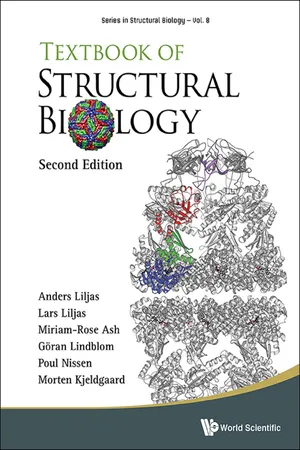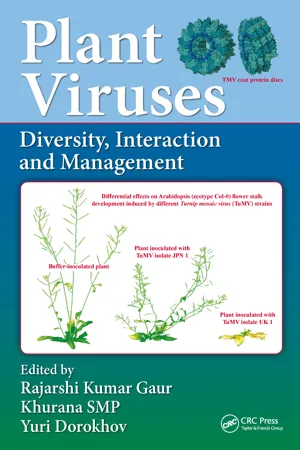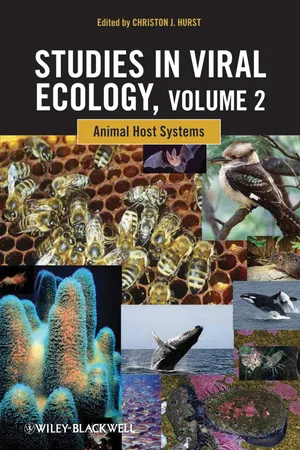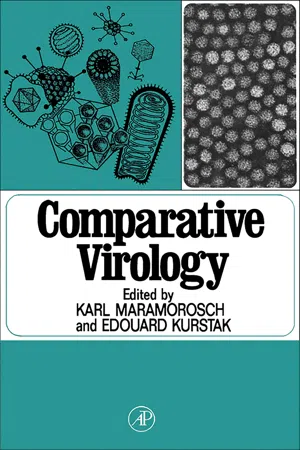Biological Sciences
Shape of Viruses
Viruses come in various shapes, including helical, icosahedral, and complex. Helical viruses have a rod-like shape, icosahedral viruses have a symmetrical, polygonal shape, and complex viruses have a combination of shapes. These shapes are determined by the arrangement of the viral capsid proteins and play a crucial role in the virus's ability to infect host cells.
Written by Perlego with AI-assistance
Related key terms
Related key terms
1 of 4
Related key terms
1 of 3
10 Key excerpts on "Shape of Viruses"
- Julius Kreier(Author)
- 2022(Publication Date)
- Routledge(Publisher)
Viruses have no intrinsic means to generate energy so they must rely totally on the metabolic machinery of host cells to synthesize new viral components. During viral replication, the nucleic acid of the virus which composes its genome becomes active within the infected cell and serves as a template to make copies of itself and to produce new viral proteins. These newly synthesized proteins and genomic elements assemble into new infectious virions that are released by cell lysis or by budding from the host cell. In some cases the viral genome may incorporate into the host cell DNA leading to persistent infections that may lead to many changes in the host cell including cancer. The genetic information in the virus genome and in the host cell determines the outcome of the virus-cell interaction.MORPHOLOGY AND STRUCTURE OF VIRUSES
The structural proteins surrounding viral genomes are arranged into one of two symmetrical forms called capsids that are either helical or icosahedral in shape. The simplest viruses consist of a rodlike helix or coil of RNA closely associated with structural proteins. There are no known animal viruses lacking an outer envelope and thus naked helical morphology; however, an example of one found in plants is the tobacco mosaic virus. The simplest animal viruses are naked icosahedral viruses such as the parvoviruses. They consist of a DNA or RNA strand within a protein shell called a capsid (Figure 16.1 A). The capsid consists of a structure created by the regular arrangement of structural subunits called “capsomeres.” Each capsomer is composed of a set of viral structural proteins. The other major forms of viruses are the enveloped icosahedral viruses such as the herpesviruses or the enveloped helical viruses such as the rhabdoviruses (Figure 16.1 B and 16.1 C). Viral nucleic acid strands with bound proteins generally have helical morphology while viral genomes within a capsid structure also referred to as a nucleocapsid are characteristically icosahedral in morphology.Figure 16.1. Morphology of viruses. Viruses all consist of either a nucleic acid core and a protective coating of protein or in some cases proteins and lipids. Animal viruses may exist in (A) naked icosahedral (B) enveloped icosahedral or (C) enveloped helical forms.- eBook - ePub
- Anders Liljas, Lars Liljas;Miriam-Rose Ash;G?ran Lindblom;Poul Nissen;Morten Kjeldgaard(Authors)
- 2016(Publication Date)
- WSPC(Publisher)
A nucleic acid molecule cannot code for a protein large enough to cover it, and this makes it necessary to form the protein shell using multiples of identical protein molecules. The need to protect the viral genome requires a stable outer shell. To achieve this, the protein subunits of the shell have symmetric arrangements, where the same protein-protein contact surfaces are used. There are essentially two kinds of symmetry found in viruses, helical symmetry and icosahedral symmetry. Helical symmetry leads to rod-shaped virus particles as in the tobacco mosaic virus and icosahedral symmetry leads to closed shells with a more or less spherical shape.The shape of the virus particle depends on the composition of the shell. Some enveloped viruses have a variable shape due to the flexibility of the membrane, while others have a defined shape based on repeated interactions between the membrane proteins themselves or with an inner symmetric protein layer. Non-enveloped viruses normally have either helical or icosahedral symmetry. Some have a more complex shape. One group of viruses, the large DNA phages, have icosahedral or elongated heads and helical tails. In phage T4, these parts are complemented with other protein complexes forming fibers and other structures important in the infection process (Section 18.4 ).18.1.2 Quasi-Equivalence
The icosahedron is an object formed by 20 equilateral triangles, and it has five-fold, three-fold and two-fold symmetry. Sixty identical units with the same environment are needed to generate an icosahedron (Figure 18.2 ). This is the highest possible symmetry in a closed object. (The dodecahedron formed by 12 pentagons has the same type of symmetry.)Some virus shells are formed by 60 copies of a coat protein, but most virus particles are formed by larger numbers of identical subunits. In 1962, long before detailed structures of viruses were known, Caspar and Klug presented the quasi-equivalence theory, which tried to explain how large numbers of coat proteins could be arranged with icosahedral symmetry. If multiples of 60 subunits are packed in a shell, identical protein molecules will have different environments. The theory is based on the assumption that the contacts between protein subunits are similar, quasi-equivalent, and use the same bonds with slight deformations. - eBook - ePub
- Boriana Marintcheva(Author)
- 2017(Publication Date)
- Academic Press(Publisher)
Fig. 1.2 ). On the molecular level, viruses could be considered as “kings and queens” of exceptions, “utilizing” unique strategies for genome replication and synthesis of viral components. That makes them an unparalleled resource for molecular tools that can be applied toward new technology development. So, how are viruses built anyway?Figure 1.2 The scale of viruses.Most viruses measure on the nanometer scale and are readily observable only with an electron microscope. One exception is giruses, such as Mimivirus, which measure on micrometer scale and can be observed under conventional light microscope.This image was originally published in Marintcheva B. A box of paradoxes: the fascinating world of viruses. Bridgew Rev (a campus faculty magazine) 2013;32 (2):25–8. http://vc.bridgew.edu/br_rev/vol32/iss2/8 and is reproduced with the permission of the editor.1.2. Overview of Viral Structure: Capsids, Genomes, and Envelopes
1.2.1. Capsids
Scientists characterize viruses by systematically evaluating the components they are built of and tracking the interactions of the viral particles with the host, both on cellular and organismal level. Naked viruses are comprised of genome and protein-based capsid. In contrast, enveloped viruses have an extra lipid-based layer, called an envelope (Fig. 1.1 ). Morphologically, viruses are described based on their shape as helical, isometric, and complex (Fig. 1.3 ). The overall shape of naked viruses is determined by the structure of their capsid. Classical example of helical virus is TMV, which appears as a thin cylinder in electron micrographs. One can figuratively think about TMV as corn on the cob in which the RNA genome builds the cob, whereas the kennels collectively represent the protein capsid, built from repetitive units or capsomers. Helical viruses are sometimes also called filamentous. For example, the shapes of Ebola virus and bacteriophage M13 are often described as filamentous. Isometric viruses are highly symmetrical and geometrically resemble icosahedron, a structure with 20 faces. Isometric capsids are built very much like soccer balls from repetitive capsomers with defined shape. If a soccer ball was indeed a viral capsid, it would contain two types of capsomers: white hexagons and black pentagons. The shapes of the capsomers and the symmetry of icosahedrons vary significantly from virus to virus (Fig. 1.4 ). Adenoviruses, polioviruses, herpesviruses, and papilloma viruses, for example, are all isometric viruses. The flu virus presents an interesting paradigm in terms of viral shape. Although its genome fragments are packed in helical nucleocapsids, the overall shape of the virus is spherical (similar to isometric viruses) due to the presence of the viral envelope surrounding all eight genomic fragments (Fig. 1.5 ). Viruses with complex shape are extremely diverse group with bacteriophage T4 “leading the pack” as the most frequent example of textbook image of a virus. T4 has well distinguishable head, tail, and attachment fibers, which in general are not typical for viruses. Viral capsids can be viewed as architectural masterpieces assembled with minimal number of building protein blocks. For example, the capsid of the polio virus is built from only three types of proteins (Fig. 1.4 - eBook - ePub
Applied Plant Virology
Advances, Detection, and Antiviral Strategies
- L. P. Awasthi(Author)
- 2020(Publication Date)
- Academic Press(Publisher)
Rao, 2006 ). The specificity of encapsulation is also triggered by coordinated packaging along with viral replication and compartmentalization.With all these coordinated efforts of the isometric viruses and the maximum enclosed volume of the shell comprising quasi-equivalent subunits, there are limitations on their capacity. Different viruses have evolved owing to variations on the basic icosahedral structure. For example, comoviruses and members of the Reoviridae have different polypeptides in different symmetry environments within the shell (Figs. 9.6 and 9.7 ). However, there are other forms of virus particles—bacilliform, for instance, Alfalfa mosaic virus(AMV) and badnaviruses, are based on icosahedral symmetry (Fig. 9.6 ).Figure 9.6 Display the differences in the basic icosahedral structure. The images were generated from the protein databank (PDB) (http://www.rcsb.org/ ) and the viral particle exposure (VIPER) database (http://viperdb.scripps.edu ).Figure 9.7 Examples of reoviruses. The images were generated from the VIPER database (http://viperdb.scripps.edu ).9.7 Bacilliform particles
Viruses such as AMV and badnaviruses, have rounded ends connected by a tubular structure. The structure of these particles was based on icosahedral symmetry (Hull, 1976 ). The 3D curvature of the round ends of icosahedra is determined by 12 pentamers (6 at each end). The 2D structure of the tubular section connecting the rounded ends is comprised of hexamers. Hull derived various hexamer structures from icosahedra cut across the twofold, threefold, fivefold, and interlattice axes (Hull, 2014 ). Similar to spherical viruses, the structures of bacilliform viruses too adopt precise geometries due to the minimal free energy of the interacting capsomeres. The energetically optimal structures also depend on the morphology of the end caps connected by the cylindrical part (Luque and Reguera, 2010 ; Luque et al., 2010 ). Hence, for T =1 particles, a threefold structure on the end caps have a slightly lower energy than its fivefold counterpart. However, the opposite is true in the case of T =3 particles. The well-studied architecture of small icosahedral or icosahedral-based plant viruses are classified into seven types (Hull, 2014 ). They are T =1 particles, bacilliform particles (T =1), geminate particles (T =1, T =3) particles, bacilliform particles (T =3), pseudo T =3 particles, and T =7 particles. The description below is elaborated in a book written by Hull (2014) - eBook - ePub
Plant Viruses
Diversity, Interaction and Management
- Rajarshi Kumar Gaur, SMP Khurana, Yuri Dorokhov(Authors)
- 2018(Publication Date)
- CRC Press(Publisher)
1 Structural Aspects of Plant VirusesSangita Venkataraman , Handanahal S. Savithri , and Mathur R.N. Murthy1.1 Introduction1.1.1 Principles of Capsid Design1.1.2 Capsid Morphologies Prevalent in Viruses1.2 Coat Protein Structure1.2.1 Techniques to Study Viral Morphology1.2.1.1 Viral Capsids as Rigid Rods1.2.1.2 Flexuous Filamentous Viruses1.2.1.3 Bacilliform Viruses1.2.1.4 Isometric Viruses1.3 ConclusionsReferences1.1 IntroductionViruses are nucleoprotein complexes that rely on specific hosts for their propagation. The protein component of the virus serves the primary purpose of protecting the genome during transmission from one susceptible host to another. Specific epitopes present on viral capsids serve to recognize host receptors during the process of cell entry. Apart from these roles, the capsids function to encapsidate the correct nucleic acid genome during the process of assembly. They disassemble to release the nucleic acid genome upon entry into a new host. In many arboviruses, the capsid serves to interact with the insect vectors during the course of transmission. In 1956, Crick and Watson realized that viruses are capable of coding for only a few species of protein molecules of limited size due to the relatively small size of their genomes (Crick and Watson 1956). Therefore, a protein shell large enough to encapsidate the genome has to be built from several copies of identical, smaller protein molecules. They also suggested that the use of identical subunits would lead to identical packing environment of subunits using symmetry principles which in turn would facilitate error-free assembly and disassembly. The basic principles underlying the design of viral capsids is discussed in the following sections.1.1.1 Principles of Capsid DesignViral capsids are made up of multiple copies of one or more protein subunits arranged with symmetry that allows their error-free assembly and stability. Based on the nature of the capsid, viruses may broadly be classified as helical, polyhedral, or complex. - eBook - ePub
- R C Matthews(Author)
- 2012(Publication Date)
- Academic Press(Publisher)
5Virus Structure
1 Physical Principles in the Architecture of Small Viruses 1.1 Regular Arrays of Protein Subunits in Rod-Shaped and Isometric Viruses 1.2 Helical Symmetries in Rod-Shaped Viruses 1.3 Possible Icosahedra 1.4 Surface Features in Small Plant Viruses with Icosahedral Symmetry 2 Examples of Plant Viruses with Different Kinds of Architecture 2.1 Small Regular Viruses with ssRNA Genomes 2.2 Viruses with dsRNA Genomes 2.3 Viruses with DNA Genomes 2.4 Viruses with Lipoprotein Envelopes 3 Interaction between RNA and Protein in Small Isometric Viruses 3.1 Viruses in Which Basic Amino Acids Bind RNA Phosphates 3.2 Polyamines Further ReadingA knowledge of the detailed structure of viruses is essential for understanding many other aspects of plant virology, for example, how viruses infect and begin replication in cells, how they survive outside cells, and how different viruses are related to one another. The methods used to elucidate virus structures were outlined in Chapter 2 .The term capsid has been used for the closed shell or tube of protein in a virus, and the term capsomere , for clusters of subunits as seen in electron micrographs. The mature virus has been termed the virion . In viruses with an outer membrane, the inner nucleoprotein core has been called the nucleocapsid . These names seem to be unnecessary and at times confusing. For example, what is the capsid or the virion in a virus whose genome is divided between several particles? Which is the capsomere in a virus in which different parts of the same protein subunit are clustered in different ways? The term encapsidation , however, is now widely used to refer to the process whereby a viral genome becomes encased in a coat of protein. This term serves a useful purpose. I shall use the term protein subunit or structural subunit to refer to the covalently linked polypeptide chain in a viral protein shell. The term morphological subunit - eBook - ePub
Studies in Viral Ecology, Volume 2
Animal Host Systems
- Christon J. Hurst, Christon J. Hurst(Authors)
- 2011(Publication Date)
- Wiley-Blackwell(Publisher)
The purpose of this book is to define the ecology of viruses and, in so doing, try to approach the question of what life is like from a “virocentric” (as opposed to our normal anthropocentric) point of view. Ecology is defined as the branch of science which addresses the relationships between an organism of interest and the other organisms with which it interacts, the interactions between the organism of interest and its environment, and the geographic distribution of the organism of interest. The objective of this chapter is to introduce the main concepts of viral ecology. The remaining chapters of this book set, Studies in Viral Ecology volumes 1 and 2, will then address those concepts in greater detail and illustrate the way in which those concepts apply to various host systems.1.1.1 What is a Virus?Viruses are biological entities which possess a genome composed of either ribonucleic acid (RNA) or deoxyribonucleic acid (DNA). Viruses are infectious agents which do not possess a cellular structure of their own, and hence are “acellular infectious agents”. Furthermore, the viruses are obligate intracellular parasites, meaning that they live (if that can be said of viruses) and replicate within living host cells at the expense of those host cells. Viruses accomplish their replication by usurping control of the host cell's biomolecular machinery. Those which are termed “classical viruses” will form a physical structure termed a “virion” that consists of their RNA or DNA genome surrounded by a layer of proteins (termed “capsid proteins”) which form a shell or “capsid” that protects the genomic material. Together, this capsid structure and its enclosed genomic material are often referred to as being a “nucleocapsid”. The genetic coding for the capsid proteins generally is carried by the viral genome. Most of the presently known virus types code for their own capsid proteins. However, there are some viruses which are termed as being “satellite viruses”. The satellite viruses encapsidate with proteins that are coded for by the genome of another virus which coinfects (simultaneously infects) that same host cell. That virus which loans its help by giving its capsid proteins to the satellite virus is termed as being a “helper virus”. The capsid or nucleocapsid is, in the case of some groups of viruses, surrounded in turn by one or more concentric lipid bilayer membranes which are obtained from the host cell. There exist many other types of acellular infectious agents which have commonalities with the classical viruses in terms of their ecology. Two of these other types of acellular infectious agents, the viroids and prions, are included in this book set and are addressed within their own respective chapters (Volume 1, chapters 10 and 12). Viroids are biological entities akin to the classical viruses and likewise can replicate only within host cells. The viroids possess RNA genomes but lack capsid proteins. The agents which we refer to as prions were once considered to be nonclassical viruses. However, we now know that the prions appear to be aberrant cellular protein products which, at least in the case of those afflicting mammals, have acquired the potential to be environmentally transmitted. The natural environmental acquisition of a prion infection occurs when a susceptible host mammal ingests the bodily material of an infected host mammal. The reproduction of prions is not a replication, but rather seems to result from a conversion of a normal host protein into an abnormal form (Volume 1, chapter 10). The Acidianus two-tailed virus, currently the sole member of the viral family Bicaudaviridae, undergoes a morphological maturation following its release from host cells and this is unique among all of the biological entities now considered to be viruses suggesting that this species may represent the initial discovery of an entirely new category of biological entities. - eBook - ePub
- Karl Maramorosch, Edouard Kurstak(Authors)
- 2014(Publication Date)
- Academic Press(Publisher)
CHAPTER 11Bullet-Shaped Viruses
KLAUS HUMMELERPublisher Summary
The group of bullet-shaped viruses is of particular interest because they parasitize vertebrates, invertebrates, and plants. Their morphology is characteristic and distinct from other viruses and therefore, it has been suggested that they should be grouped into a new genus. The taxonomy of these viruses is still unsatisfactory and presents some difficulties. The vesicular stomatitis virus is the most extensively investigated member of this group and is generally considered the prototype. Therefore, originally, it was suggested to name the genus stomatoviridae. This is obviously inappropriate in view of the biological activities of other members of this group. The criterion for relegating viruses into this genus is based merely on structure and hence, a term expressing those characteristics would be more valid. Most of the vertebrate viruses of this group resemble a bullet. They are elongated with one rounded and one planar end. Therefore, the term bullet-shaped virus has been used extensively.I Introduction II StructureA Dimensions B Surface Structure C Internal Structure D Aberrant StructuresIII Biochemical and Biophysical PropertiesA Nucleic Acids B ProteinsIV Antigenic PropertiesA Serological Reactivities B HemagglutininsV MorphogenesisA Vertebrate Viruses B Plant VirusesVI Summary ReferencesI Introduction
The group of bullet-shaped viruses are of particular interest because they parasitize vertebrates, invertebrates, and plants. Their morphology is characteristic and distinct from other viruses and, therefore, it has been suggested that they should be grouped into a new genus. New members are reported with an increasing frequency. Beyond structural details, however, little is known about biological, physical, and biochemical properties of many of them, although some of them have been investigated in detail. It remains to be seen whether all of these agents belong properly to a single genus, but enough similarities as well as differences in their properties are known at this time to make a comparative analysis useful. - eBook - ePub
- Donald Voet, Judith G. Voet(Authors)
- 2021(Publication Date)
- Wiley(Publisher)
29 Viruses: Paradigms for Cellular Functions1 Tobacco Mosaic VirusA. StructureB. Assembly2 Icosahedral VirusesA. Virus ArchitectureB. Tomato Bushy Stunt VirusC. PicornavirusesD. Simian Virus 40 (SV40)E. Bacteriophage MS2F. Bluetongue VirusG. Paramecium bursaria Chlorella Virus3 Bacteriophage λA. The Lytic PathwayB. Virus AssemblyC. The Lysogenic ModeD. Mechanism of the λ Switch4 Influenza VirusA. Virus Structure and Life CycleB. Mechanism of Antigenic VariationC. Mechanism of Membrane FusionViruses (Latin: poison) are parasitic entities, consisting of nucleic acid molecules with protective coats, that are replicated by the enzymatic machinery of suitable host cells. Since they lack metabolic apparatus, viruses are not considered to be alive (although this is a semantic rather than a scientific distinction). They range in complexity from satellite tobacco mosaic virus (STMV; Section 29-2Bc ), whose 1059-nt genome encodes only one 159-residue protein, to mimivirus, whose 1181-kb genome encodes ∼911 proteins [to put this latter number into perspective, the smallest known genome of a cellular organism, that of the obligate insect endosymbiont Carsonella ruddii (Table 6-3 ), consists of 160 kb and encodes 182 proteins].Viruses were originally characterized at the end of the nineteenth century as infectious agents that could pass through filters that held back bacteria. Yet viral diseases, varying in severity from smallpox and rabies to the common cold, have no doubt plagued mankind since before the dawn of history. It is now known that viruses can infect plants and bacteria as well as animals. Each viral species has a very limited host range; that is, it can reproduce in only a small group of closely related species. Recent investigations have revealed that viruses are highly abundant in oceans, where they have an average concentration of ∼3 × 109 particles/L. Thus, viruses comprise the second largest component of the oceanic biomass after prokaryotes (they are estimated to collectively contain ∼1012 - eBook - ePub
- Nigel J. Dimmock, Andrew J. Easton, Keith N. Leppard(Authors)
- 2015(Publication Date)
- Wiley-Blackwell(Publisher)
Comprehensive Virology (H. Fraenkel-Conrat, R. R. Wagner, Eds), Vol.13, pp. 543–580. Plenum Press, New York.- Crowther, R. A. 2008. The Leeuwenhoek Lecture 2006. Microscopy goes cold: frozen viruses reveal their structural secrets. Philosophical Transactions of the Royal Society of London B: Biological Sciences 363, 2441–2451.
- Johnson, J. E. 2003. Virus particle dynamics. Advances in Protein Chemistry 64, 197–218.
- Rixon, F. J., Chiu, W. 2003. Studying large viruses. Advances in Protein Chemistry 64, 379–408.
- Smith, T. J., Baker, T. 1999. Picornaviruses: epitopes, canyons, and pockets. Advances in Virus Research 53, 1–23.
- Stuart, D. 1993. Virus structures. Current Opinion in Structural Biology 3, 167–174.
- Tyler, K. L., Oldstone, M. B. A. 1998. Reoviruses I. Structure, proteins and genetics. Current Topics in Microbiology and Immunology 233, 1–213.
- Wiley, D. C., Skehel, J. J. 1987. The structure and function of the hemagglutinin membrane glycoprotein of influenza virus. Annual Review of Biochemistry 56, 365–394.
- Zhou, Z. H., Chiu, W. 2003. Determination of icosahedral virus structures by electron cryomicroscopy at sub-nanometer resolution. Advances in Protein Chemistry 64, 93–124.
- For images of virus particles see the Virus Particle Explorer (VIPER) website: http://viperdb.scripps.edu
Passage contains an image
Chapter 3 Classification of Viruses
Viruses are found throughout the world and infect all known organisms. Viruses may cause a range of different diseases and display a diversity of host range, morphology and genetic makeup. Bringing order to this huge diversity requires the designation of classification groups to permit study of representative viruses that can inform us about their less well-studied relatives.
Index pages curate the most relevant extracts from our library of academic textbooks. They’ve been created using an in-house natural language model (NLM), each adding context and meaning to key research topics.
Explore more topic indexes
Explore more topic indexes
1 of 6
Explore more topic indexes
1 of 4









